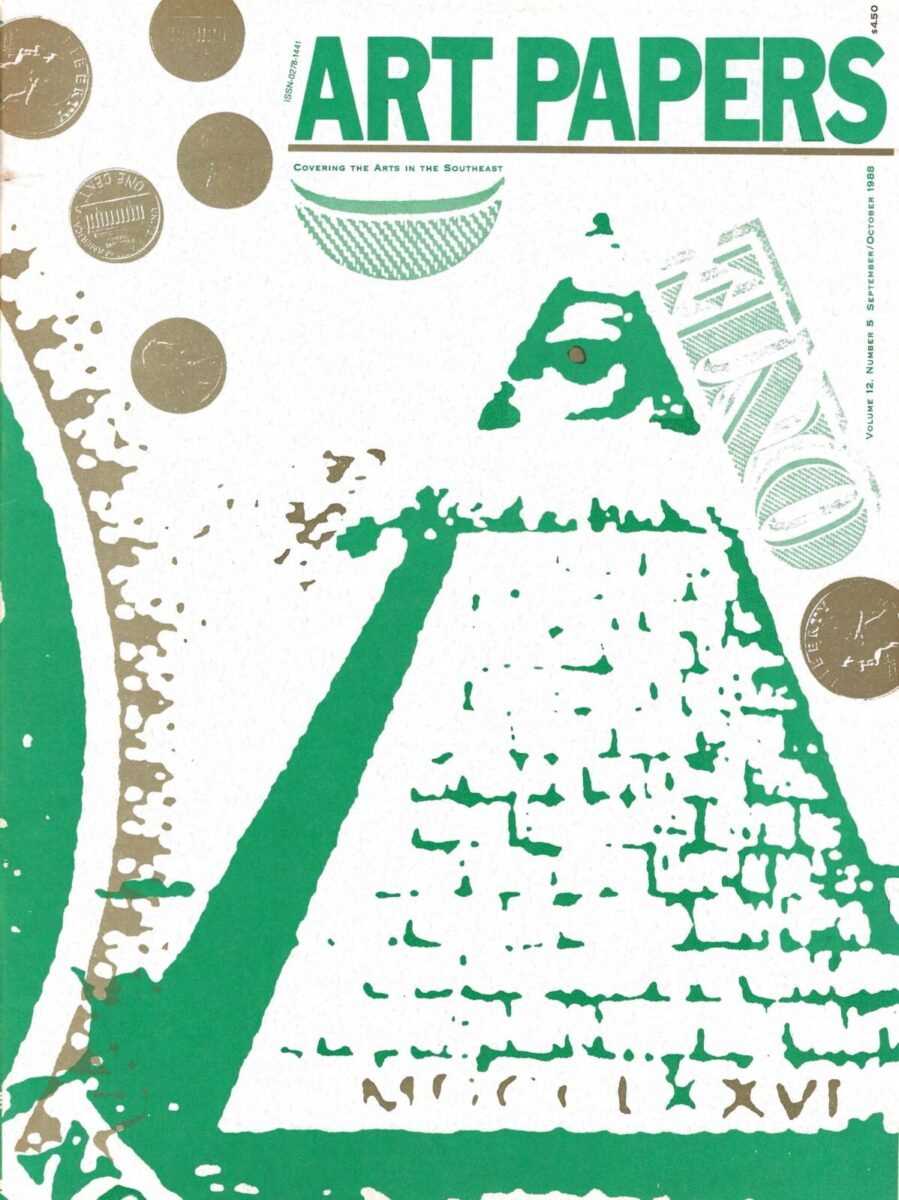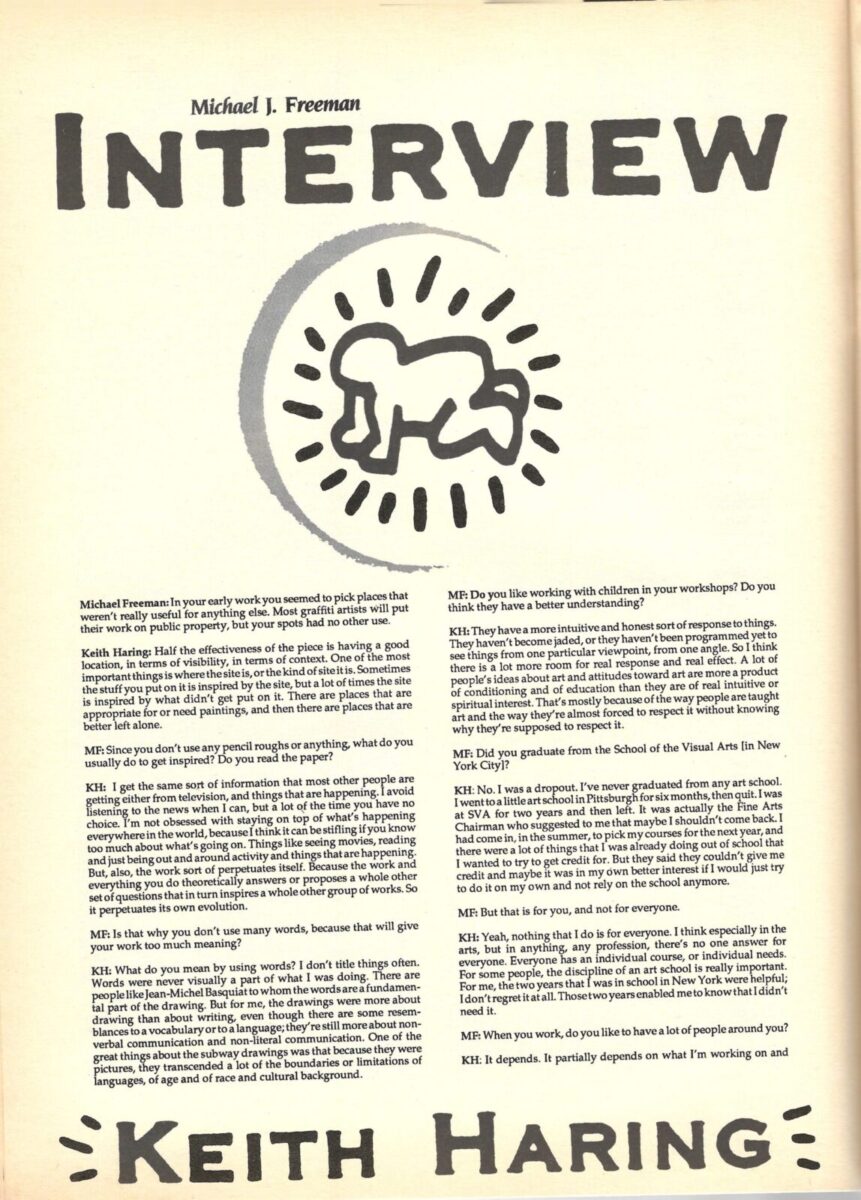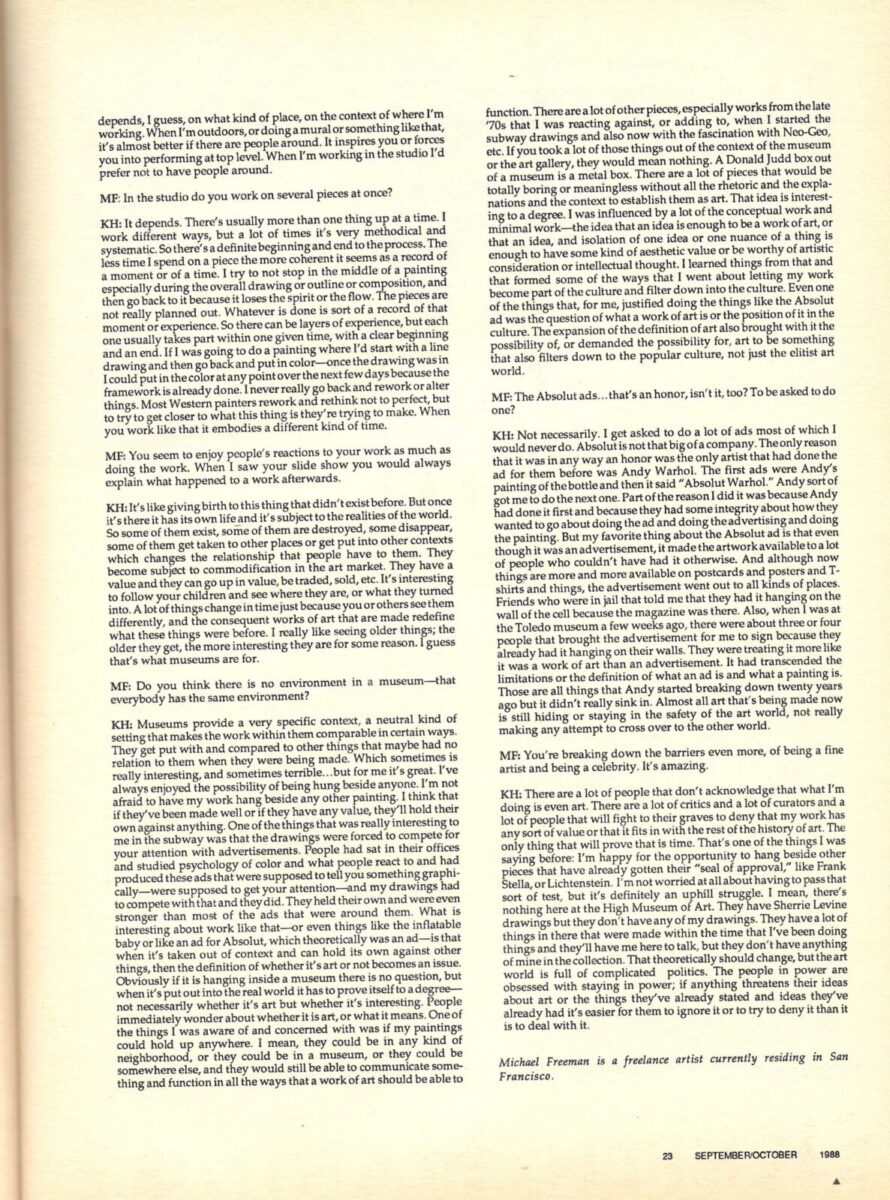Interview: Keith Haring
Keith Haring at work in the Stedelijk Museum in Amsterdam [photo: Rob Bogaerts; courtesy of Wikimedia Commons and Nationaal Archief]
Share:
This interview was originally published in ART PAPERS September/October 1988, Vol 12, issue 5.
Michael Freeman: In your early work you seemed to pick places that weren’t really useful for anything else. Most graffiti artists will put their work on public property, but your spots had no other use.
Keith Haring: Half the effectiveness of the piece is having a good location, in terms of visibility, in terms of context. One of the most important things is where the site is, or the kind of site it is. Sometimes the stuff you put on it is inspired by the site, but a lot of times the site is inspired by what didn’t get put on it. There are places that are appropriate for or need paintings, and then there are places that are better left alone.
MF: Since you don’t use any pencil roughs or anything, what do you usually do to get inspired? Do you read the paper?
KH: I get the same sort of information that most other people are getting either from television, and things that are happening. I avoid listening to the news when I can, but a lot of the time you have no choice. I’m not obsessed with staying on top of what’s happening everywhere in the world, because I think it can be stifling if you know too much about what’s going on. Things like seeing movies, reading and just being out and around activity and things that are happening. But, also, the work sort of perpetuates itself. Because the work and everything you do theoretically answers or proposes a whole other set of questions that in turn inspires a whole other group of works. So it perpetuates its own evolution.
MF: Is that why you don’t use many words, because that will give your work too much meaning?
KH: What do you mean by using words? I don’t title things often. Words were never visually a part of what I was doing. There are people like Jean-Michel Basquiat to whom the words are a fundamental part of the drawing. But for me, the drawings were more about drawing than about writing, even though there are some resemblances to a vocabulary or to a language; they’re still more about non-verbal communication and non-literal communication. One of the great things about the subway drawings was that because they were pictures, they transcended a lot of the boundaries or limitations of languages, of age and of race and cultural background.
MF: Do you like working with children in your workshops? Do you think they have a better understanding?
KH: They have a more intuitive and honest sort of response to things. They haven’t become jaded, or they haven’t been programmed yet to see things from one particular viewpoint, from one angle. So I think there is a lot more room for real response and real effect. A lot of people’s ideas about art and attitudes toward art are more a product of conditioning and of education than they are of real intuitive or spiritual interest. That’s mostly because of the way people are taught art and the way they’re almost forced to respect it without knowing why they’re supposed to respect it.
MF: Did you graduate from the School of the Visual Arts [in New York City]?
KH: No. I was a dropout. I’ve never graduated from any art school. I went to a little art school in Pittsburgh for six months, then quit. I was at SVA for two years and then left. It was actually the Fine Arts Chairman who suggested to me that maybe I shouldn’t come back. I had come in, in the summer, to pick my courses for the next year, and there were a lot of things that I was already doing out of school that I wanted to try to get credit for. But they said they couldn’t give me credit and maybe it was in my own better interest if I would just try to do it on my own and not rely on the school anymore.
MF: But that is for you, and not for everyone.
KH: Yeah, nothing that I do is for everyone. I think especially in the arts, but in anything, any profession, there’s no one answer for everyone. Everyone has an individual course, or individual needs. For some people, the discipline of an art school is really important. For me, the two years that I was in school in New York were helpful; I don’t regret it at all. Those two years enabled me to know that I didn’t need it.
MF: When you work, do you like to have a lot of people around you?
KH: It depends. It partially depends on what I’m working on and depends, I guess, on what kind of place, on the context of where I’m working. When I’m outdoors, or doing a mural or something like that, it’s almost better if there are people around. It inspires you or forces you into performing at top level. When I’m working in the studio I’d prefer not to have people around.
MF: In the studio do you work on several pieces at once?
KH: It depends. There’s usually more than one thing up at a time. I work different ways, but a lot of times it’s very methodical and systematic. So there’s a definite beginning and end to the process. The less time I spend on a piece the more coherent it seems as a record of a moment or of a time. I try to not stop in the middle of a painting especially during the overall drawing or outline or composition, and then go back to it because it loses the spirit or the flow. The pieces are not really planned out. Whatever is done is sort of a record of that moment or experience. So there can be layers of experience, but each one usually takes part within one given time, with a clear beginning and an end. If I was going to do a painting where I’d start with a line drawing and then go back and put in color-once the drawing was in I could put in the color at any point over the next few days because the framework is already done. I never really go back and rework or alter things. Most Western painters rework and rethink not to perfect, but to try to get closer to what this thing is they’re trying to make. When you work like that it embodies a different kind of time.
MF: You seem to enjoy people’s reactions to your work as much as doing the work. When I saw your slide show you would always explain what happened to a work afterwards.
KH: It’s like giving birth to this thing that didn’t exist before. But once it’s there it has its own life and it’s subject to the realities of the world. So some of them exist, some of them are destroyed, some disappear, some of them get taken to other places or get put into other contexts which changes the relationship that people have to them. They become subject to commodification in the art market. They have a value and they can go up in value, be traded, sold, etc. It’s interesting to follow your children and see where they are, or what they turned into. A lot of things change in time just because you or others see them differently, and the consequent works of art that are made redefine what these things were before. I really like seeing older things; the older they get, the more interesting they are for some reason. I guess that’s what museums are for.
MF: Do you think there is no environment in a museum—that everybody has the same environment?
KH: Museums provide a very specific context, a neutral kind of setting that makes the work within them comparable in certain ways. They get put with and compared to other things that maybe had no relation to them when they were being made. Which sometimes is really interesting, and sometimes terrible…but for me it’s great. I’ve always enjoyed the possibility of being hung beside anyone. I’m not afraid to have my work hang beside any other painting. I think that if they’ve been made well or if they have any value, they’ll hold their own against anything. One of the things that was really interesting to me in the subway was that the drawings were forced to compete for your attention with advertisements. People had sat in their offices and studied psychology of color and what people react to and had produced these ads that were supposed to tell you something graphically—were supposed to get your attention-and my drawings had to compete with that and they did. They held their own and were even stronger than most of the ads that were around them. What is interesting about work like that–-or even things like the inflatable baby or like an ad for Absolut, which theoretically was an ad—is that when it’s taken out of context and can hold its own against other things, then the definition of whether it’s art or not becomes an issue. Obviously if it is hanging inside a museum there is no question, but when it’s put out into the real world it has to prove itself to a degree—not necessarily whether it’s art but whether it’s interesting. People immediately wonder about whether it is art, or what it means. One of the things I was aware of and concerned with was if my paintings could hold up anywhere. I mean, they could be in any kind of neighborhood, or they could be in a museum, or they could be somewhere else, and they would still be able to communicate something and function in all the ways that a work of art should be able to function. There are a lot of other pieces, especially works from the late ’70s that I was reacting against, or adding to, when I started the subway drawings and also now with the fascination with Neo-Geo, etc. If you took a lot of those things out of the context of the museum or the art gallery, they would mean nothing. A Donald Judd box out of a museum is a metal box. There are a lot of pieces that would be totally boring or meaningless without all the rhetoric and the explanations and the context to establish them as art. That idea is interesting to a degree. I was influenced by a lot of the conceptual work and minimal work—-the idea that an idea is enough to be a work of art, or that an idea, and isolation of one idea or one nuance of a thing is enough to have some kind of aesthetic value or be worthy of artistic consideration or intellectual thought. I learned things from that and that formed some of the ways that I went about letting my work become part of the culture and filter down into the culture. Even one of the things that, for me, justified doing the things like the Absolut ad was the question of what a work of art is or the position of it in the culture. The expansion of the definition of art also brought with it the possibility of, or demanded the possibility for, art to be something that also filters down to the popular culture, not just the elitist art world.
MF: The Absolut ads…that’s an honor, isn’t it, too? To be asked to do one?
KH: Not necessarily. I get asked to do a lot of ads most of which I would never do. Absolut is not that big of a company. The only reason that it was in any way an honor was the only artist that had done the ad for them before was Andy Warhol. The first ads were Andy’s painting of the bottle and then it said “Absolut Warhol.” Andy sort of got me to do the next one. Part of the reason I did it was because Andy had done it first and because they had some integrity about how they wanted to go about doing the ad and doing the advertising and doing the painting. But my favorite thing about the Absolut ad is that even though it was an advertisement, it made the artwork available to a lot of people who couldn’t have had it otherwise. And although now things are more and more available on postcards and posters and T- shirts and things, the advertisement went out to all kinds of places. Friends who were in jail that told me that they had it hanging on the wall of the cell because the magazine was there. Also, when I was at the Toledo museum a few weeks ago, there were about three or four people that brought the advertisement for me to sign because they already had it hanging on their walls. They were treating it more like it was a work of art than an advertisement. It had transcended the limitations or the definition of what an ad is and what a painting is. Those are all things that Andy started breaking down twenty years ago but it didn’t really sink in. Almost all art that’s being made now is still hiding or staying in the safety of the art world, not really making any attempt to cross over to the other world.
MF: You’re breaking down the barriers even more, of being a fine artist and being a celebrity. It’s amazing.
KH: There are a lot of people that don’t acknowledge that what I’m doing is even art. There are a lot of critics and a lot of curators and a lot of people that will fight to their graves to deny that my work has any sort of value or that it fits in with the rest of the history of art. The only thing that will prove that is time. That’s one of the things I was saying before: I’m happy for the opportunity to hang beside other pieces that have already gotten their “seal of approval,” like Frank Stella, or Lichtenstein. I’m not worried at all about having to pass that sort of test, but it’s definitely an uphill struggle. I mean, there’s nothing here at the High Museum of Art. They have Sherrie Levine drawings but they don’t have any of my drawings. They have a lot of things in there that were made within the time that I’ve been doing things and they’ll have me here to talk, but they don’t have anything of mine in the collection. That theoretically should change, but the art world is full of complicated politics. The people in power are obsessed with staying in power; if anything threatens their ideas about art or the things they’ve already stated and ideas they’ve already had it’s easier for them to ignore it or to try to deny it than it is to deal with it.
Michael Freeman is a freelance artist currently residing in San Francisco.


